This week, Kat Arney has been through the archives and picked out her personal Naked highlights, including making experimental jelly, sneezing at computer screens, stabbing potatoes and Ben dancing (badly) in the studio. She looks back on advances in cancer therapy, developments in making people bionic and how new diseases emerge, as well as reliving the chance to meet Alan Titchmarsh, for a chat about the importance of ponds. Plus, we have a brand new bit of the Naked Scientists, where we're looking at Chemistry in its element.
In this episode
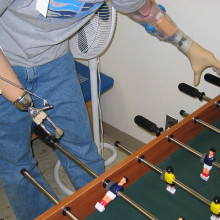
02:02 - Implanted Electronics and Artificial Skin
Implanted Electronics and Artificial Skin
with Dr Stephanie Lacour, Cambridge Nanoscience Centre
Kat - We're joined by Stephanie Lacour from the Cambridge Nanoscience Centre where she's working on making flexible electronics that could be worn over your skin or maybe even under your skin. Hello, Stephanie. Thanks for coming on the show. Tell us about your aim. What's the issue that you're trying to address?
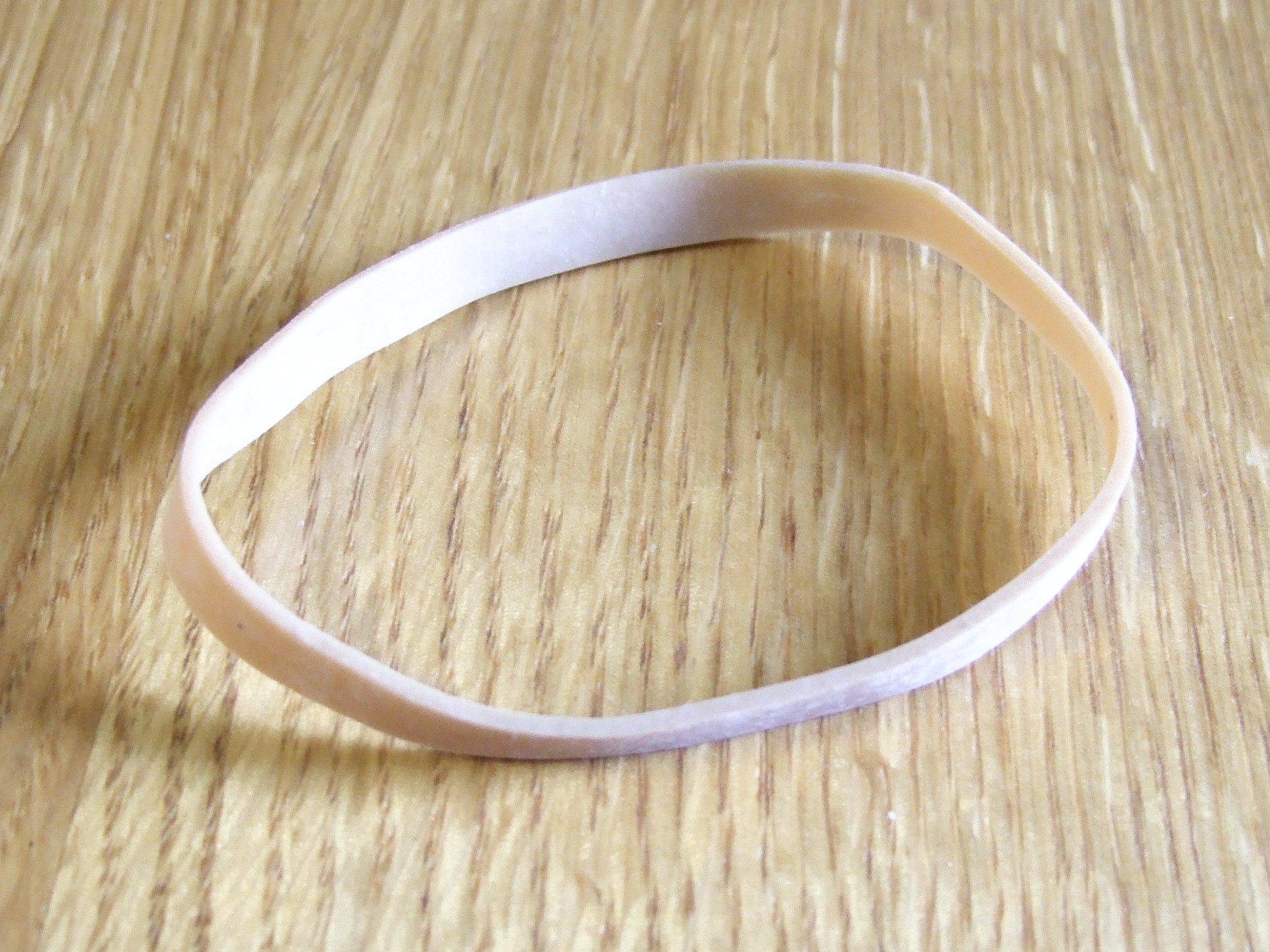 Stephanie - What we're trying to do is to interface electronic components with the human body. One of the challenges is that conventional electronics is typically made on very hard and flat surfaces. If you look at our own body we are a 3D object that is moving all around. The challenge is not only electrical but also mechanical because we need to find ways to make electronic things that can conform the body and therefore use materials that are no longer hard and brittle but materials that can be elastic, similar to our own skin, for example.
Stephanie - What we're trying to do is to interface electronic components with the human body. One of the challenges is that conventional electronics is typically made on very hard and flat surfaces. If you look at our own body we are a 3D object that is moving all around. The challenge is not only electrical but also mechanical because we need to find ways to make electronic things that can conform the body and therefore use materials that are no longer hard and brittle but materials that can be elastic, similar to our own skin, for example.
Kat - A kind of bionic man-type thing?
Stephanie - Yeah, I was thinking about the six million dollar man, basically.
Kat - What are the sort of challenges? What do you need to make electronics do to make them like skin?
Stephanie - There are two challenges. The first one is to find ways to put electronic components onto a substrate that is very soft. The electronic processes that are available today are usually using fairly high temperature deposits using material. The substrate we're using to make skin-like devices are polymers. In particular we're working with materials called elastomers.
Kat - So they're very bendy?
Stephanie - It's like a rubber band material. These materials don't withstand very high temperature. We need to find processes to deposit the device material at very low temperatures, specifically below 150 degrees C. That's one challenge. Once we've found a way to deposit this material directly on the soft material we have to find a good design or overall architecture for the system so that the electronics can withstand the mechanical deformation. It's one thing to actually deposit the materials onto the substrate but we also want to make sure the transistor is still working when there's cooling onto the transistor.
Kat - Because obviously transistors are made of things like silicon and you don't think of that as very flexible. How are you trying to get round this problem?
Stephanie - The approach we're following is to distribute onto the very soft substrate tiny platforms that would be rigid. This tiny platform would host a very fragile material like the silicon for the transistors. Once you have this pig cell structure all across the elastomer we would need to use very elastic interconnects to connect one platform to the other so they can talk together. What we found a few years ago - I found a way to make stretchable metal. By depositing very thin layers of gold directly into an elastomer on a rubber band I found that I can stretch it up to twice its length and it will not fade electrically. From there we've decided to push forward the technology and use these stretchable metals as interconnects for the electronics.
Kat - Basically, you've got an elastic band covered in gold with all these little transistors studded into it. They'll communicate with each other?
Stephanie - Yes, exactly.
Kat - What sort of applications do you see for this kind of technology?
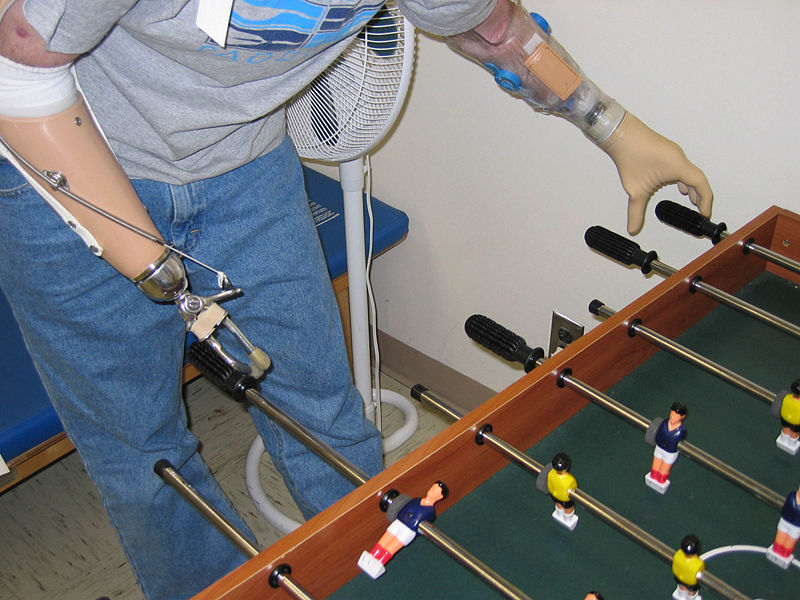 Stephanie - I'm particularly interested in interfacing with the human body. There is a lot of application in biomedical research. One particular project we're looking at is how to make prosthetic skin. The skin of a patient who's lost a limb, for example, they could wear this like a glove. They could wear this on top of the prosthetic limb and the skin would allow them to get some sensory feedback which is not possible today.
Stephanie - I'm particularly interested in interfacing with the human body. There is a lot of application in biomedical research. One particular project we're looking at is how to make prosthetic skin. The skin of a patient who's lost a limb, for example, they could wear this like a glove. They could wear this on top of the prosthetic limb and the skin would allow them to get some sensory feedback which is not possible today.
Kat - So they'd be able to feel how hard they were touching something or how hot and cold they were?
Stephanie - Exactly. We're trying to implement various sensors directly onto this rubbery substrate like temperature or touch sensors so that we can mimic sensory function that is embedded in our own skin.
Kat - how are things going at the moment? What sort of stage are we at?
Stephanie - We're at the very first stage. At the moment we're really evaluating the technology to make these. We know how to make stretchable metal so we're investigating how we can implement this to make touch sensors. This is where we're pretty much in the sensing at the moment. We're also evaluating how to make the transistors directly onto this rubbery substrate with a platform. We're just starting so this is where we're at.
Kat - Presumably a big issue is trying to make all this electronics talk to the human brain. It is nerves and electrical impulses.
Stephanie - Right. This is the second aspect of the project. In my group we're looking at ways to make these prosthetic skins but there's also this application where we're looking at a way to use these very soft electronic devices to interface everything with the nervous system. Because the human body and particularly the nervous system is made of extremely compliant material we cannot use a silicon chip to interface directly with your nerve for a long time. What we're doing is to use this polymer and elastomer substrate with embedded electrodes in it to connect directly with a peripheral nerve - so a nerve which is in the limb, not in the spinal cord or the brain - really in the limb, from the electrical signal from the neurons. Once we can do that then the idea would be to connect these peripheral implant directly to the prosthetic skin so that we could take the signals that are coming out of the prosthetic skin and convert them into a neuron format and feed that directly into the implant which would then communicate to the nerve and back to the brain.
Kat - It sounds like exciting stuff. Presumably you have a multidisciplinary team so you have to bring a lot of different people together. What sort of range of scientists are working on this kind of technology?
Stephanie - I'm an electrical engineer by training but in the team we have people who are material scientists, biophysicists and neurosurgeons. Particularly for the project onto the peripheral implant I'm working with lots of people in Cambridge and a couple of other universities in the UK - it's extremely important to collaborate between engineers and the medical field. Without good collaboration we could not do that.
Kat - And when do you think we might see the bionic man?
Stephanie - Not tomorrow! It will take quite a long time. Surely along the way we'll have some devices where you'll have for clinical application but for the final project it could be 25 years or so.
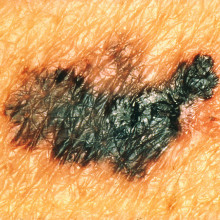
08:19 - Mounting an Immune Attack Against Tumours
Mounting an Immune Attack Against Tumours
with Cassian Yee, Fred Hutchinson Research Centre
Chris - Recently researchers at the Fred Hutchinson Research Centre in Seattle have been using this approach to 'cure' - I'm using this word very carefully. They have successfully managed to cure a patient who had malignant melanoma. Cassian Yee is the researcher who's been leading this work. He joins us now, hello Cassian.
Cassian - Hello, how do you do?
Chris - Very well, thank you. How does this technique to persuade the immune system to attack the tumour really work?
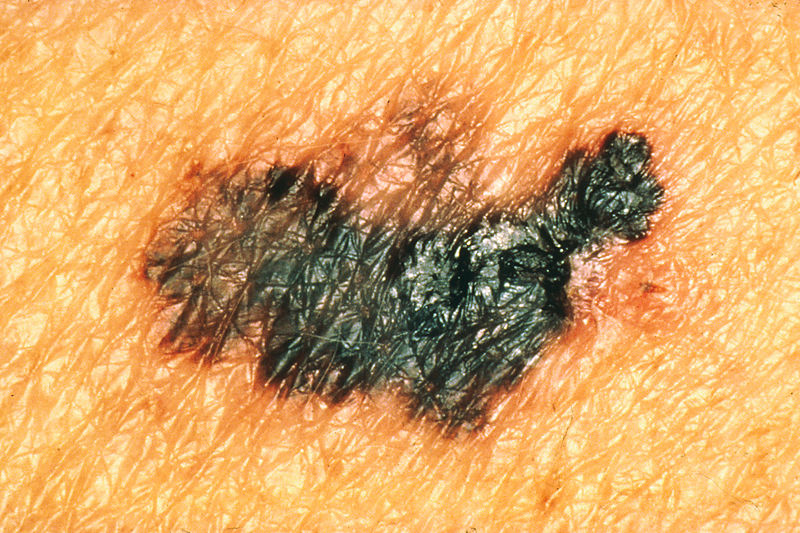 Cassian - We use a process known as adoptive immunotherapy. That involves collecting white blood cells. The cells that you mention can fight infection but can also fight tumour and taken from these white blood cells, a population of cells known as T cells which specifically recognise the patient's tumour cells. In the lab we can isolate those rare T cells that can recognise and kill the melanoma cells. Melanoma cells express a target antigen. If we can expand enough of these T cells, we actually clone them as single cells, and introduce them back in the patient it's hoped that they can travel to the melanoma site and recognise and eradicate the tumour cells.
Cassian - We use a process known as adoptive immunotherapy. That involves collecting white blood cells. The cells that you mention can fight infection but can also fight tumour and taken from these white blood cells, a population of cells known as T cells which specifically recognise the patient's tumour cells. In the lab we can isolate those rare T cells that can recognise and kill the melanoma cells. Melanoma cells express a target antigen. If we can expand enough of these T cells, we actually clone them as single cells, and introduce them back in the patient it's hoped that they can travel to the melanoma site and recognise and eradicate the tumour cells.
Chris - Why don't the T cells, if the patient's already got them to start with and you're just increasing the numbers, why don't they go in there and wipe out the tumour for the patient without any help from you?
Cassian - Yeah, so that's a very good question. For a long time people felt like perhaps these cells do exist in the body. It turns out that using specialised techniques to detect these cells they are present but in very low numbers. I think you mentioned earlier in the programme that the body sometimes suppresses the immune response against normal cells. Part of this suppressant mechanism may prevent these T cells from recognising tumours as well. Using The process of adoptive therapy we're able to isolate these cells outside the lab and expand them without the constraints that might be present in the body that limit their expansion against the tumour cells. On top of that the tumour cells themselves have evasive mechanisms. They find ways to prevent the immune system from revving up and recognising them by releasing suppressive factors or by co-opting immune suppressor cells to prevent the immune system from recognising and expanding them. I think by removing them from that environment and putting them back in, in expanded numbers, we might be able to override some of these immune escape mechanisms.
Chris - One of the interesting things about treating cancers is that when you start to treat them, because cancers are already genetically deranged, in other words their DNA is all over the place, this means that cancers are not all the same and therefore some cells will be killed by certain therapies. Others will disguise themselves, look a bit different and they escape therapy because they evolve ways of being unresponsive to the drugs and so on. Why doesn't that happen here? Why don't you end up with a clone of cancer cells that aren't recognised by these immune T cells you're putting back in and therefore they escape and put the cancer back?
Cassian - That's a very good question and that's one of the major obstacles for immune therapy or any type of specific therapy. In this case we did originally do the study with one type of T cell - the CD8 T cells and found that had in some of our patients where the tumour cell was able to evade detection by suppressing expression of the antigen that was recognised by the T cell. In this case we used a different type of T cell - CD4. This T cell not only may kill the tumour cells directly by recognising this antigen but it may also recruit other immune cells that can kill in a non-specific fashion. One thing with the CD4 T cell which we've expanded in the lab and given back to the patient goes to the tumour site. The CD4 T cell may release other chemokines or cytokines that bring to the tumour site other immune effector cells which may kill the tumour non-specifically regardless of whether they express the antigen levels targeted in the first place or not. By bringing to bear other immune effector cells we may be able to eradicate tumour cells whether they express the antigen or not. One thing we did find in the paper in some of our patients is that when this happened the tumour cell breaks down and because the CD4 T cell is present and causes inflammatory response other antigens are brought to light and the body's own immune response takes over and starts to direct its own T cells that we didn't grow in the lab but were already there to expand and grow and kill other targets on the tumour cell.
Chris - What's the risk, having said what you said, that you might end up with inappropriate attack? In other words if you look at certain diseases like thyroid disease or rheumatoid arthritis and certain types of diabetes that's where the immune system is inappropriately attacking healthy tissue. If you're priming the immune system like that and getting this spill-over to other bits of the immune system what's the danger - or is there a danger that you might get an auto-immune disease and instead of just attacking tumours these cells then start attacking something else you don't want them to hit?
Cassian - That's a very good question. In part that might be limited by the local effect with the initial homing or trafficking of the T cells that we gave to the patients end up expanding. That's a local inflammatory process where we've targeted the tumour specifically and it may set off an inflammatory environment that causes an immune reaction to occur. That's not to say that some of these cells can't travel to other sites and cause some auto-immunity. In fact we have seen some auto-immunity in patients where some of the target antigens on the cells are also expressed on normal cells. In the case of melanoma some of these targets are pigmented proteins so whatever is responsible for the colouration on your skin. When we start killing the tumour cells some of the T cells may also end up killing normal pigmented skin cells and we see a whitening, a lightening colour on normal skin. That type of autoimmunity is not too toxic. It's still relatively safe in terms of patient discomfort. When we see this we also recognise that if patients have a high likelihood of responding as well to the immunotherapy. What's happening in the normal cells is also happening to the tumours. There is some auto-immunity but we think a lot of it is concentrated where the initial inflammatory reaction occurs.
Chris - Finally Cassian, you've done this with malignant melanoma. That's an important problem because the numbers have gone up in this country at least 100% in the last ten years. Every Western country has seen lots of malignant melanoma but we're also seeing lots of other cancers, particularly things like lung cancer. Will the same approach that you've taken also apply to other types of tumours?
Cassian - Yes. We've taken melanomas as sort of a model tumour because a lot of the target antigens are known for it. We know that there are T cells are generated that will recognise those target antigens. It turns out there are also antigens that are shared with lung cancer, breast cancer and prostate cancer however a lot of those studies are in very early stages while people work out what the differences are in the conditions and what the timing of immune-therapy is for treating other types of cancer.
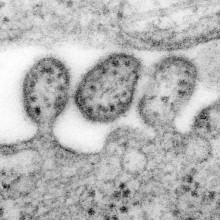
14:52 - Catching New Viruses
Catching New Viruses
with Professor Robert Swanepoel, National Institute for Communicable Dieases, South Africa
Chris - Hello, Bob.
Bob - Hello, there.
Chris - Welcome to the Naked Scientists. Tell us what happened with this case. Tell us about this history.
Bob - Well this is a travel agent, a 36-year-old lady who worked in Lusaka. Unfortunately shortly after she got ill - you know the beginning of diseases is always milder than what comes later - she went from Lusaka down to a wedding in South Africa and then went back because there was some confusion as to about whether she actually picked up the infection in South Africa or Lusaka.
Chris - What were the symptoms she was complaining of?
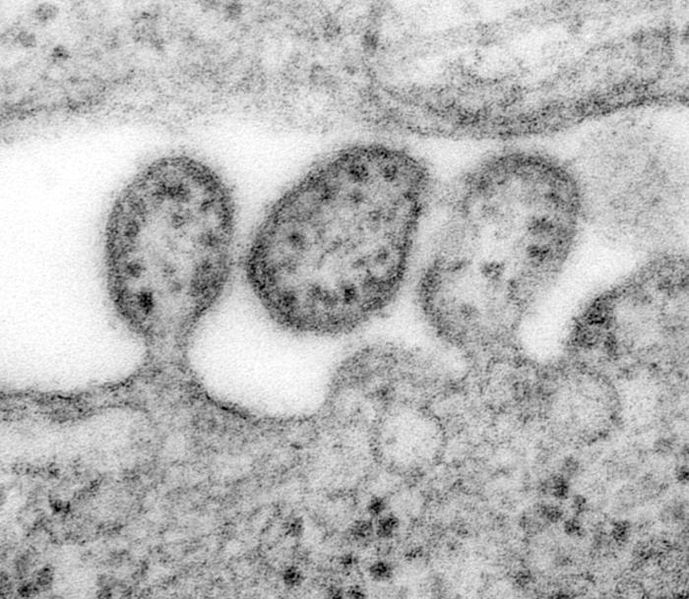 Bob - Initially, I mean with any of these things if you're talking about Ebola or severe diseases, people start off with non-specific pain. The same way flu starts with headache and muscle pain and just not feeling well and fever and rigour. That was how she started. She was taking pills for headache and that sort of thing. She went down to the wedding in South Africa and she returned on Sunday evening. From the Monday she was feeling extremely ill and couldn't go back to work at all. She saw several doctors in town and by the Friday she was medically evacuated to South Africa and the following day she died.
Bob - Initially, I mean with any of these things if you're talking about Ebola or severe diseases, people start off with non-specific pain. The same way flu starts with headache and muscle pain and just not feeling well and fever and rigour. That was how she started. She was taking pills for headache and that sort of thing. She went down to the wedding in South Africa and she returned on Sunday evening. From the Monday she was feeling extremely ill and couldn't go back to work at all. She saw several doctors in town and by the Friday she was medically evacuated to South Africa and the following day she died.
Chris - What was the cause of death?
Bob - At that stage what normally happens is that people who are extremely ill, whether it be Ebola or anything else, the infection's really similar to anything with bacterial infection or so-called septicaemia. It could be meningococcal septicaemia so a very similar picture. Clinically the clinicians do the right thing. They pump them full of antibiotics to save their life but the trouble is then if you do a blood culture to diagnose the illness you're not going to find the answer because there's always antibiotics. People die of one illness like that in every city every day. They have this septicaemia and so there was nothing that was deemed to be unusual about it. She was deemed to be a bacterial septicaemia and she died and no results were obtained.
Chris - So how did you find out it was something unusual?
Bob - It was only some days later, two weeks later, when a paramedic who'd flown down in the air ambulance with her came down with the same symptoms and was also medically evacuated. People put two and two together and realised there was something unusual and that's often the case. Talking about emerging diseases earlier in this programme, quite often people can have an emerging disease and a one-off like that you don't notice. It's only with accumulated evidence. When the second person came down and that person developed the same symptoms and it happened to be at the same hospital a day later. The physician recognised this looked identical to the first one.
Chris - Can you tell us what the actual organism was that they were suffering from and where it came from?
 Bob - Well this whole group of organisms are known to be associated with rodents. They cause chronic infection in rats and mice of various species. Each of these viruses tends to be associated with a particular rat or rodent species.
Bob - Well this whole group of organisms are known to be associated with rodents. They cause chronic infection in rats and mice of various species. Each of these viruses tends to be associated with a particular rat or rodent species.
Chris - How do you think the lady got it from the rat?
Bob - That's a big question yet to be answered. One of the things is there was a lot of confusion initially. Did she become sick in Zambia or South Africa? We believe it was Zambia and one of the things that has been suggested is an increase in wheat farming. It's not that is just more has been planted per acreage because the price has gone up. That's the sort of thing that happens in nature with human intervention, that we create a bonus situation for rats and mice. With all this wheat around them, grain crops, there's a population explosion. Maybe that had something to do with it because she lived on the edge of town and indeed worked on the edge of town.
Chris - Can you tell us briefly what can you do about this in the future and what's the likelihood of it recurring?
Bob - Well, I suspect it will recur and suggest that we will be better geared-up next time to recognise it. I think even in Zambia the physicians are really good at knowing what to look for.
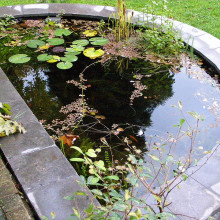
23:24 - The Million Pond Project
The Million Pond Project
with Alan Titchmarsh, gardening broadcaster & novelist; Jeremy Biggs, Pond Conservation
Kat - Now over the recent decades ponds have vanished from our natural environment but the charity Pond Conservation is embarking on an ambitious project to see thousands of new ponds being created in the U.K. Have you noticed the quality of ponds changing over recent years?
 I went along to the launch of their Million Ponds Project to find out more and one special guest at the event was gardener and broadcaster Alan Titchmarsh. He is so lovely. So I started off by asking him why ponds are such an important part of our landscape.
I went along to the launch of their Million Ponds Project to find out more and one special guest at the event was gardener and broadcaster Alan Titchmarsh. He is so lovely. So I started off by asking him why ponds are such an important part of our landscape.
Alan - The greatest thing about ponds is that for something so relatively small the wildlife they support is absolutely huge. If you think of the things within the landscape that use a pond, from birds coming down to drink, hedgehogs and mammals coming down to drink. The pond life that's in the depths there and in the shallows from pond skaters and water boatmen to newts, frogs, toads, damsel flies, dragon flies, you start to build up this list and you think all that just for a little patch of clean water, and that's the vital thing and the answer is yes, and anybody can make one.
It is so simple - you can do it in an afternoon. Make a small pond, take charge of it; make it clean. You think 'Well, hang on a minute, how am I going to introduce all that wildlife to it?' You don't have to; it will come. The most astonishing thing is that all that wildlife finds you of it's own accord.
Kat - How would someone go about digging a pond? What would be your top tips for them?
Alan - Oh it's not just the quality of ponds it's the amount of ponds. We are losing numbers of ponds that are disappearing. I am lucky enough to live in a village which has a village pond, which is fed by natural stream. So it is wonderful. It stays clean. But they are disappearing. They get filled in and they get polluted, that's one of the most difficult things, we have run off from farmland and nitrates.
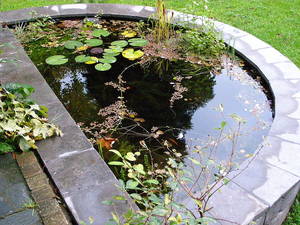 Our clean ponds are now very few in number. I think it's about 80% of our ponds are no longer clean but it is not difficult to pull that right. I think that's the great appeal of Million Ponds is the fact that we can address this quite easily, relatively quickly and also quite economically.
Our clean ponds are now very few in number. I think it's about 80% of our ponds are no longer clean but it is not difficult to pull that right. I think that's the great appeal of Million Ponds is the fact that we can address this quite easily, relatively quickly and also quite economically.
Kat - How much fun can you have with ponds?
Alan - People tend to make ponds either too small and they heat up like saucepans on a hot summer's day or too deep, strangely enough. They think a pond is going to be about four feet... 18 inches in the middle is ample, go to two feet if you want, make sure it's got shallows so things can get in and get out and there's more life in the shallows of pond than there are in the depths.
If you have a 3-foot deep pond there's nothing much living right down the bottom there at all, one or two amphibians might hibernate there but most of them hibernate outside the pond, I mean under stones and things like that.
So it's so easy with a decent liner that can't get perforated and a bit of under lay, a bit of soil on top of it and then you can either fill it or you can be very patient, and wait for a rainy day. It's so easy, it's easy as that.
Kat - So ponds are easy to make and they are more fun than watching TV. To find out more about the Million Ponds Project I spoke to Jeremy Biggs, Policy & Research Director at Pond Conservation.
Alan - My big thing about ponds is exactly that and that to me is the essence of conservation. There tends to be a lot of finger wagging in conservation terms and the onus is on you and it's a weighty responsibility. It is the greatest joy in life to do something which improves that nasty thing called the environment. I am certain my life's work is to find a better word for environment. I like landscape, that's much nicer.
It is so joyous you introduce children to gardening too, and that's the sort of sharp end, if you like, of conservation, just dabbling around in the soil with a trowel making a pond, looking at pond life. They are entranced by it and that's far more and I say this as someone who knows, far more to watch in a pond than there's on telly.
Kat - So ponds are easy to make and they are more fun than watching TV. To find out more about the Million Ponds Project I spoke to Jeremy Biggs, Policy & Research Director at Pond Conservation.
Jeremy - Million Ponds Project is a five-year initiative to add about 4,000 new ponds to the countryside and in the longer term to double the number of ponds in the British landscape to get back to the million ponds or so that we had at the beginning of the 20th century.
So over the next 50 years we are going to make 500,000 new ponds to replace those old ones that we have lost.
 Kat - It sounds ambitious. Who is going to help you do this?
Kat - It sounds ambitious. Who is going to help you do this?
Jeremy - Well there are all sorts of people making ponds. It is actually not as ambitious as it sounds, I would say. When you look around the countryside it's about 20 ponds a day being made by people already. So that's five or 6,000 a year. So actually all we need to do really is just to capitalise on that work that they are already doing out there and make it a bit better and make them help people to get the best of the pond creation, of work they are already doing very often.
The people would be doing it, really again that's all kinds of people, from big organisations like the R.S.P.B., the National Trust, the Environment Agency, right through to the individual land owners and land managers. People can even make ponds at home in their garden as well.
Kat - And what are the risks of not bringing by the ponds? How we see the environment change as a result of losing so many ponds?
Jeremy - There are so many things that live in ponds, about two-thirds of all types of fresh water plants and animals there are can be found in ponds. So if you lose those ponds and in particular if when so many of them damaged by pollution and other impacts, so it's about 80% which are in poor condition. When so many are damaged and degraded, that means there's just less habitat available for a whole range of fresh water plants and animals, many of which have now become rare, most of the things which need clean water are struggling now-a-days. There's just nowhere left for them to go.
So by putting back that clean water we hope to take the pressure off a bit, let things spread out again, just to give them the refuge.
Kat - And finally tell me about your favourite pond?
Jeremy - Well I have got lots of favourite ponds, actually to be honest, almost any pond which is clean and unpolluted, has a rich stands of plants under the water. When you take a pond that you dip it, you see lots of different kinds of animals in the water. There are lots of amphibians around. These are not so common these days.
So almost anywhere where you see something like that, that's one of my favourite places. Of course you can see these dotted around the countryside still from the south of England, from the Lizard Peninsula, in the far south west, right through to the far North West highlands of Scotland. You can find them dotted around. To be honest, those are really all my favourites.
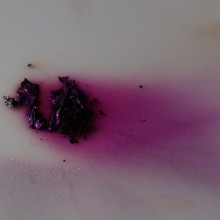
34:36 - Chemistry in its Element - Iodine
Chemistry in its Element - Iodine
with Dr Andrea Sella, UCL
When I was a child, I used spend a couple of weeks each summer high in the Italian Alps in an idyllic little village called Cogne that nestles quietly between high ice-clad peaks. To most Italians, the name is associated with a sensational murder. Others, know that in winter the valley has some of the finest ice-climbing in the Alps. But to me, Cogne will always be connected with the element iodine.
 One afternoon, when I was around 10 years old, returning with my Dad from a long hike, we passed a dull gray building on the edge of the village. It was surrounded by a tall metal fence and had an institutional look about it. Sitting on the bench all on his own was a strange-looking old man - he had rather shaggy hair, a vacant look, and a large, distended pouch of skin where his neck should have been. I was utterly shocked by this strange being. I pestered my father with questions. Who was he? What was wrong with him? Why did he look so sad?
One afternoon, when I was around 10 years old, returning with my Dad from a long hike, we passed a dull gray building on the edge of the village. It was surrounded by a tall metal fence and had an institutional look about it. Sitting on the bench all on his own was a strange-looking old man - he had rather shaggy hair, a vacant look, and a large, distended pouch of skin where his neck should have been. I was utterly shocked by this strange being. I pestered my father with questions. Who was he? What was wrong with him? Why did he look so sad?
My father, whose patience in the face of a barrage of questions was almost infinite, explained that the poor man had grown up with insufficient iodine in his diet. Iodine, he went on, was essential for the proper development of the thyroid gland in the neck, and that if one didn't eat the right kind of salt, especially as a child, one might develop goitre and one's mental development would also be affected. I would later read of English travellers passing through the Alps referring to The Valleys of the Cretins - travel books of the period would include lurid illustrations of the poor unfortunates. The numbers were staggering; the Napoleonic census of the canton of Valais in 1800 found 4000 cretins in a population of 70,000 - well over 50% of the population would have had goiter.
The disease had been known to medical writers for centuries. Galen for example recommended treatment with marine sponges. In 1170 Roger of Salerno recommended seaweed. Similar suggestions were also made in China.
Paracelsus, the great renaissance healer, alchemist, and writer was one of the first to spot the connexion between goiter and cretinism, and first suggested that minerals in drinking water might play a role in causing the condition. But what these mysterious minerals might be was a mystery.
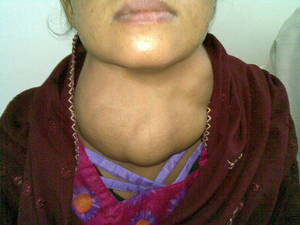 In 1811 a young French chemist, Bernard Courtois, working in Paris stumbled across a new element. His family's firm produced saltpetre, needed to make gunpowder for Napoleon's wars. They used wood ash in their process and wartime shortages of wood forced them instead to burn seaweed, plentiful on the coastlines of northern France. Adding concentrated sulphuric acid to the ash, Courtois, obtained an unexpected purple vapour that crystallized onto the sides of the container. Astonished by this discovery he bottled up the crystals and sent them to one of the foremost chemists of his day Joseph Gay-Lussac who confirmed that this was a new element and named it iode - iodine - after the Greek word for purple. Courtois continued to play with the element and was rather shocked to discover that when mixed with ammonia it produced a chocolate-coloured solid - the ammoniate of nitrogen tri-iodide - that exploded violently at the least provocation. His contemporary, Pierre Dulong, was less fortunate, losing an eye and part of a hand while studying the material, the first in a long list of casualties from this notorious explosive.
In 1811 a young French chemist, Bernard Courtois, working in Paris stumbled across a new element. His family's firm produced saltpetre, needed to make gunpowder for Napoleon's wars. They used wood ash in their process and wartime shortages of wood forced them instead to burn seaweed, plentiful on the coastlines of northern France. Adding concentrated sulphuric acid to the ash, Courtois, obtained an unexpected purple vapour that crystallized onto the sides of the container. Astonished by this discovery he bottled up the crystals and sent them to one of the foremost chemists of his day Joseph Gay-Lussac who confirmed that this was a new element and named it iode - iodine - after the Greek word for purple. Courtois continued to play with the element and was rather shocked to discover that when mixed with ammonia it produced a chocolate-coloured solid - the ammoniate of nitrogen tri-iodide - that exploded violently at the least provocation. His contemporary, Pierre Dulong, was less fortunate, losing an eye and part of a hand while studying the material, the first in a long list of casualties from this notorious explosive.
The toxic qualities of iodine were also soon realized, and the tincture, a yellowish-brown solution of iodine in alcohol began to be widely used as a disinfectant. Even today, the most common water purification tablets one can buy in travel shops, are based on iodine.
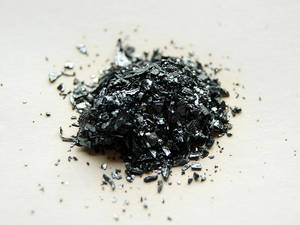 It was only two years after its discovery, that a doctor in Geneva, Francois Coindet, began to wonder whether it wasn't the iodine in the seaweed that was the missing mineral responsible for goiter. He therefore began administering tincture of iodine to his patients by mouth - an unpleasant business - but, he reported, it led to the disappearance of swellings in 6 to 10 weeks. His colleagues, however, accused him of poisoning his patients, and at one point he was said to be unable to go into the streets for fear of being attacked.
It was only two years after its discovery, that a doctor in Geneva, Francois Coindet, began to wonder whether it wasn't the iodine in the seaweed that was the missing mineral responsible for goiter. He therefore began administering tincture of iodine to his patients by mouth - an unpleasant business - but, he reported, it led to the disappearance of swellings in 6 to 10 weeks. His colleagues, however, accused him of poisoning his patients, and at one point he was said to be unable to go into the streets for fear of being attacked.
While elemental iodine undoubtedly was toxic, Coindet was on the right track. During the 19th century, by a process of one step forward two steps back, the hypothesis gradually gained credence, as experiments using the more palatable salt, potassium iodide, showed that goitres could be reversed. By the early 1920's, Swiss cantons began to introduce iodized salt and over the following decades many countries that had been plagued by goitre followed suit. The policy has been so effective that many of us in the developed world are unaware of how serious a disease this had been, and the word cretin has lost much of its meaning.
When I returned to Cogne last summer, I tried to remember where the institute had been. All I could find was a summer holiday camp, with children playing happily behind the gates where I had seen the old man. I phoned my Dad to ask him, and we chatted about the old days - the bad old days of the cretins - and of ghosts banished by that unique purple element, iodine.
For more Chemistry in its Element, or the latest in Chemistry news from Chemistry World - visit the
Royal Society of Chemistry's Website.
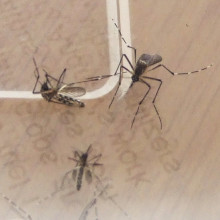
Mosquitoes make sweet music together
We normally think of a mosquito's buzz as being an overture for biting, but in fact it's more like a lover's aria. At least, if you're another mosquito.
Writing in the journal Science, Lauren Cator, from Cornell University in the US, has found that male and female Aedes aegypti mosquitoes harmonise their buzzing just before mating, creating what must be the world's most irritating duet.
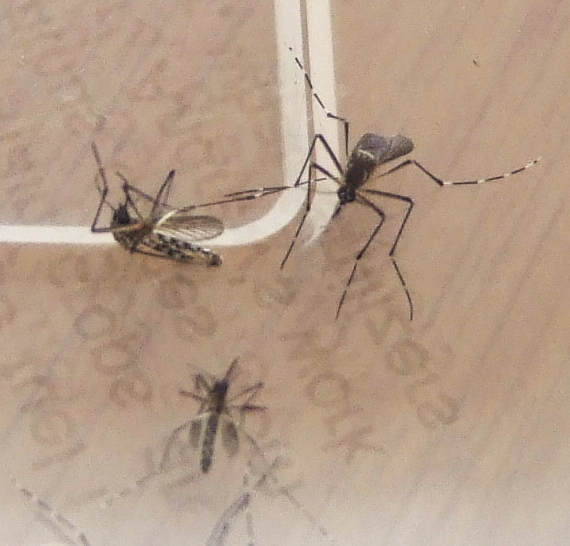 The scientists carried out some very fiddly experiments involving mosquitoes tied to pins, moving one past the other to simulate courtship. Females beat their wings at a frequency of around 400 hertz (roughly a concert A, for any musicians listening), while males beat at a higher-pitched 600 hertz (that's about a fourth higher). But just before they mate, they adjust the resonance of their thoraxes to produce a buzz of 1,200 hertz - a harmonic that's about an octave and a half above the female mosquito's pitch. And they could even get mosquitoes to harmonise with a simulated tone played through an earphone.
The scientists carried out some very fiddly experiments involving mosquitoes tied to pins, moving one past the other to simulate courtship. Females beat their wings at a frequency of around 400 hertz (roughly a concert A, for any musicians listening), while males beat at a higher-pitched 600 hertz (that's about a fourth higher). But just before they mate, they adjust the resonance of their thoraxes to produce a buzz of 1,200 hertz - a harmonic that's about an octave and a half above the female mosquito's pitch. And they could even get mosquitoes to harmonise with a simulated tone played through an earphone.
What's interesting about these findings is that they overturn the conventional wisdom that male mosquitoes can't hear anything above 800 hertz, and that female mosquitoes are completely deaf. They discovered this by taking careful electrical readings from the insects' antennae and Johnston's organs- the mosquito equivalent of our ears.
But there's also something more important at stake. The mosquitoes that Cator and her team studied spread nasty - and even fatal - diseases like yellow fever and dengue fever. Dengue fever affects 50 million people around the world.
The researchers found that female mosquitoes who had just mated were much less likely to harmonise with male tones, suggesting they're not really up for it again.
So the scientists suggest that releasing lots of sterile males into areas plagued by the mosquitoes might lead to female mosquitoes mating with them, which would not result in baby mosquitoes. And then the females would be less likely to go on to mate with fertile males. So it could help to control the population.

50:00 - Dancing in your Genes
Dancing in your Genes
with Peter Lovatt, University of Hertfordshire
Kat - Time to get your dancing shoes on! It seems that the way you dance could say something about your genetic fitness - in other words, how good your genes would be to pass on to the next generation. Joining us now to explain how dancing could broadcast your fitness is Dr Peter Lovatt, from the University of Hertfordshire. Good evening...
Peter - Good evening.
Kat - Well, Peter, tell us a bit about why is it important to actually study dancing?
 Peter - Well because there's a very clear relationship between people's level of testosterone and what's called their genetic quality and the way in which the dance. Now it's thought to be that dancing might be, as Darwin suggested, some kind of courtship ritual so that like other birds and animals we may display ourselves in a particular way to find a mate which is compatible with us. That's not quite scientific but it becomes more scientific when you realise that they way in which you move might be determined by both our level of prenatal testosterones and also by our physical symmetry. That is, how physically symmetrical we are in terms of our ears and our fingers and knees and ankles.
Peter - Well because there's a very clear relationship between people's level of testosterone and what's called their genetic quality and the way in which the dance. Now it's thought to be that dancing might be, as Darwin suggested, some kind of courtship ritual so that like other birds and animals we may display ourselves in a particular way to find a mate which is compatible with us. That's not quite scientific but it becomes more scientific when you realise that they way in which you move might be determined by both our level of prenatal testosterones and also by our physical symmetry. That is, how physically symmetrical we are in terms of our ears and our fingers and knees and ankles.
Kat - How does that work?
Peter - Two earlier studies have shown that. They asked men in to dance, they filed them into a lab. They filmed them dancing and then blurred the images out so you couldn't see anything about the physical attributes of the men at all. Then these videos were shown to a large group of women and the women were asked to rate which movements were the most attractive and dominant and masculine. What they found was that the movements of men who have the largest amounts of prenatal testosterone, all men who had higher levels of physical symmetry were rated as more attractive, more dominant and more masculine than the dances of the opposite men.
Kat - Does this mean that some people then are basically born dancers.
Peter - What it suggests is that according to the original research is that the testosterone has an organising effect on the body movements. The men don't even know they have high or low testosterone but it influences how they move. It might influence their level of coordination in terms of their movement, or might influence their natural rhythm and how different parts of their bodies move together.
Kat - We know there's loads of programmes on TV here at the moment - you know - 'Strictly Come Dancing' and 'Tap Dance Your Way to Success' or whatever they're called. Can people actually learn to dance well or is there always going to be this genetic barrier to it?
Peter - I think that people can learn. It might well be the case that your genetic make-up might predetermine the range of your dancing abilities so it might suggest that you're more rhythmic or you might use more complex movements. Of course then we can teach people a different, wider range of movements or a set of movements that might make them appear more dominant and attractive.
Kat - Well, we're going to try this experiment live now. Are you ready for this Peter? We have our dancing monkey here, Ben Valsler who's going to do his dance for us.
Peter - I'm more than happy. Peter, I know that at the moment you are running a survey online and I've watched your video about the different styles of dancing and you want people to let you know - classify their dancing and let you know how they dance. We will link to this from the Naked Scientists.com so people can join in. I think it's only fair that seeing as Kat hasn't seen the video that I demonstrate for her in the studio. So please could you describe to Kat the sort of movements that we're looking for and I will do the movements for you?
Kat - So run the music...
Peter - So the first set of movements is you just step from one foot to the next foot. Stepping right and touching left. The normal kind of disco movement you see at discos.
Kat - It's what you did at school!
Peter - Now keep that quite small and keep the top half of the body doing the same as the bottom half.
Kat - This looks brilliant.
Peter - Now that is the most unattractive dance that we could do.
Kat - You're telling me!
Peter - Now what you can do now, if you keep doing that same thing but do something different with your shoulders. Roll your shoulders backwards slightly and move your arms up. Move your elbows around a little bit.
Kat - Ben's now doing a dancing like your dad kind of dance.
Peter - Ooh. As long as your top half is doing something different to your bottom half and it's in time with the music and there's a rhythm going on. If there's a rhythm going on and it's coordinated then that would be more attractive to women. Apparently. Now f the top half of his body was a bit more random them it wouldn't be quite so attractive.
Kat - Yes, he's doing some very random things with his arms - over the head - swimming motions.
Peter - That's interesting. If he's doing all that they might be a bit too big. The bigger the movements are the more dominant they're seen by people. If they're large moments and largely coordinated but unthreatening then they could be seen to be attractive and masculine. If they get too big and too random movements then those ones are seen as highly dominant, highly unattractive.
Kat - So you've got the hands waving over the head now - windmill style.
Peter - Yeah, you're not going to attract any mates that way, I'm afraid.
Ben - I'm taking up most of the studio, I think.
Kat - I really wish the webcam was working, this is great! Are there any other moves we can get Ben to do or is that the repertoire?
Peter - Make the side-to-side a bit bigger so they're quite small steps but make the bigger. Step about a metre from side to side.
Kat - It's like the Hulk.
Peter - And now get the arms swinging out wide.
Kat - It's like he's doing aerobics.
Peter - That's right. A bit like a star jump. What he's doing now is making his movement a lot more dominant.
Kat - It's not attractive.
Peter - It's not, is it. It's interesting you say that because some women do find it attractive. The ones who do that are the younger women - 16-18-19 year-olds often find those movements quite attractive.
Kat - So any of our teenage listeners out there, Ben is now the man of your dreams.
Peter - He might well be. He might be now - obviously it's a bit too stylised at the moment. What he needs to do is put a bit more randomness into it.
Kat - More randomness. Yep, he's doing waving his arms now.
Peter - Now if you think of being a hip hop dancer and do some big hip hop dancing.
Kat - Yeah he's got some hip hop moves - a bit of arm crossing. He's doing a little sign with his hands there.
Peter - Now all those movements are making him much more obvious on the dance floor. As you're doing those movements you're much more likely to see him. As long as he's not too threatening the younger girls would go for those kinds of moves. They would be impressed.
Kat - There you go, Ben. Next time you're down the teenage disco. The final thing I'd really like to know is, all your studies seem to have focussed on men dancing. In my experience, men don't dance that well. Is it really true that girls are better dancers than men?
Peter - What we've done is we've just - on the survey we've got online at the moment - women are rating themselves as much better dancers than men. The problem is so many girls have had some kind of formal dance training, even if it was only a few years in jazz, tap or ballet when they were much younger. Whereas men often don't have formal dance training. When we are looking at natural dance - the real sort of dance that's coming out in their genes it's less contaminated by training.
Kat - So men may be naturally very proficient dancers but they may not know.
Peter - Yes, a lot of them might be. Once they relax a bit more you really see some fantastic moves in men. Even if they're not formally recognisable moves you really see some great rhythm in men.
Kat - How long are you conducting this survey for?
Peter - We wanted to conduct this survey for as long as we possibly can, really. The survey we are doign at the moment we want to find out how good people think that are at dancing and we want to find out what sort of movements they characterise by their dancing. What we found is that with men under the age of 25, their level of testosterone predicts how good a dancer they say they are. The high testosterone men say they're good dancers. The low-testosterone men are bad dancers. In the over 25s the pattern goes away but the men are still very good. We want to know what sort of movements men are using with all different ages through their life.
You can classify your own dance moves by watching Peter's videos
here.
Then tell him how well you thinkyou dance on his survey,
here.
- Previous Malaria, Orchids, Hornets and Coral
- Next The Darwin Festival
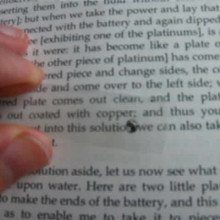
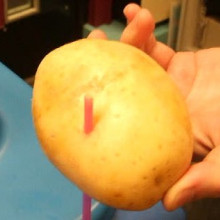
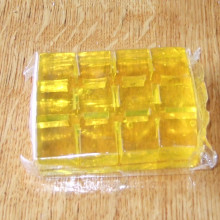









Comments
Add a comment